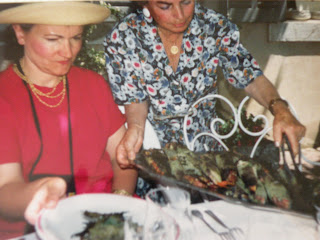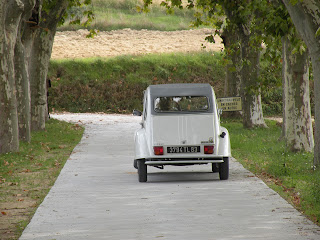Cassis is my favorite little fishing village in France and is where we were staying. There is a beautiful little port, with nice restaurants and bars lining the quai. In the water are small, colorful fishing boats and in the morning the fishermen sell the fish they caught that day. There is a nice cafe, called the Bar de la Marine, where we would go in the mornings for breakfast. The restaurants all serve the freshest of fish and the best thing to order is bouillabaisse, the amazing huge plate of fish boiled in a soup of tomatoes and saffron and served with aioli. In the town square, old men play petanque. They will tell you here that it was Cassis where petanque was first played many years ago. Not sure about that, but it makes for a good story for the town.
One evening, Jean Marie, Catherine, Annie and I went to a very nice restaurant in Le Castellet, which is the hill village right above the Domaine (and was the place where they filmed Marcel Pagnol’s masterpiece, La Femme du Boulanger, in the 1930s). Now it’s a nice tourist town, the typical ‘village perché’ that are all over the South of France. It has narrow, winding streets, old homes (most with their windows shuttered) and stores selling lavender, herbs de Provence and postcards. There are beautiful views from all sides of the village of the Provençal countryside. At the time, there was a Michelin 1 star restaurant that Jean Marie and Catherine recommended, so we went there for dinner. Annie and I usually didn’t go in for starred restaurants, country bistros were more our thing. But I must say it’s nice to be pampered once in awhile…waiters at your beck and call, nice table settings, a beautiful view out the window. And the food! I can’t remember all we had, but I do remember the amazing plateau de fromage. Well, it was more like a cart of fromage, where the waiter came by pushing a cart on wheels and it had a huge assortment of cheeses. Also, this restaurant was a client of Jean Marie’s so they had Tempier on the menu. I’m pretty sure, however, that Jean Marie brought his own bottles to the restaurant.
The next evening, Jean Marie and Catherine invited us to their place at La Migoua. They lived in an old house (18th Century, I’m thinking) right in the middle of their La Migoua vineyards. It was a beautiful old house with huge wooden beams in the ceiling. On the patio, Jean Marie cooked some lamb chops in a barbeque he had constructed years before. With this, Catherine served some roasted potatoes that I have been trying to duplicate ever since, without success.
Annie and Catherine at La Miguoa...
Jean Marie with his hand made barbeque...
The next day was the Big Surprise. It so happened that at the same time we were travelling in Provence, Annie’s younger sister from Poitiers, Marinette, and our nice and nephew from the USA, Veronique and Drew (Veronique is the daughter of Annie’s oldest sister, Mauricette and Drew was her husband at the time) were also there. They wanted to meet us at Domaine Tempier, but we told them that we would already be gone by the time they got there. Well of course we were still there and just wanted to surprise them. We had to tell Drew what was going on so he would get everyone to the Domaine by 11am, as they were going to have a tasting with Jean Marie.
We arrived at the Domaine a little early and were ushered into the living room by Lulu. Out came a bottle of rosé and we had a nice talk waiting for Marinette, Veronique and Drew. The plan was that Lulu would bring them into the living room and there we’d be. The plan went perfectly. Lulu brought them into the room, Jean Marie was up front to shake their hands and out we popped! Luckily, I was able to snap a photograph at the exact moment they saw us. The look of surprise on Veronique and Marinette’s faces was priceless!
Marinette and Veronique look a bit suprised...
We all sat around and talked for awhile and Drew handed out a couple of presents he had made; hand drawn Domaine Tempier logos on a couple of baseball hats for Jean Marie and Lucien. They looked great! And they were happy to know that, as far as we knew, these were the only Domaine Tempier baseball hats in the entire world.
Lucien and his new hat...
The very dapper Jean-Marie...

From left; Catherine, Drew, Jean-Marie, Lucien, Lulu, Annie, Marinette and Veronique...
Drew, Jean-Marie, Annie, Veronique and Marinette pose in the vineyards...
But now it was time for business…a trip down to the cellars for a tasting! Jean Marie showed us the big steel vats where they put the grape juice in and where it magically turns to wine and then down to the cellar with the big foudres.
We tasted the blanc and the rosé, the five 1990 reds which were still in barrel and the ’89 Cabassaou, which was also still in barrel. Ah, magnificent, as always. I'm sure this was quite the eye opener for Drew, Vero and Marinette, as it had been for me everytime I'd entered this hallowed ground. Tasting young wines out of the barrel is a lot of fun, delicious and quite educational. Well, fun and delicious anyway.
I think Annie and Drew are indicated the number of bottles so far...
Le pére et le fils...
About this time, Lucien came down to join us with some small appetizers Lulu had sent down with him. He sat down in his chair and tasted the wines with us. Again, he was quite poetic talking about the different vintages and comparing them to classical music composers. I just loved listening to Lucien talk about his wines. At one point, Veronique sat down with him and Lucien became fascinated and quite amused with some little frogs she had on her shoes.
Lucien always has something beautiful to say about his wine...
But we weren’t anywhere near finished with the tasting. Jean Marie went to the cellar and got out a 1985 La Miguoa and a 1988 La Louffe. The La Louffe was a very special bottle. It was made from a small parcel of the La Miguoa vineyard, mostly made with mourvedre. They only made this particular cuveé in 1987, 1988 and 1989, as it was thought by Jean Marie to take too much away from the La Miguoa cuveé. But what a bottle it was, one of the three best bottles of Tempier I have ever tasted (the other two being the 1988 Cabassaou and the 1971 Cuveé Speciale). It was so full of flavor, incredible deep and just lingered in the mouth for minutes after drinking (alas, I drank my last bottle years ago). Jean-Marie also brought out a bottle of the magical 1971 Cuvee Speciale and a rosé from 1967! A rosé, almost 25 years old you say? How could any rosé be alive after all of this time. Robert Parker, probably the most influential wine critic in the world, once called Tempier's rosé the best in the world. But he probably never tasted one this old. The color was beautiful, not the bright pinkish red of a young rosé, but a darker, garnet like color. And what flavor...llike no rosé I have ever tasted. It was much deeper and had that aged quality that is hard for someone like me, who is not a wine writer, to explain. Suffice it to say it was magnificent.
We were all having an amazing time. Veronique, Drew and Marinette, who were ‘virgins’ with this Tempier experience and Annie and me, who had had a couple of tastings by Jean Marie before, but never one like this, where he kept going back in the private cellar to bring out yet another bottle from a past vintage. I think Jean Marie, whose job, after all, was to bring clients down here for tastings, had a great time himself, as this wasn’t just a tasting for professionals or clients, but a full on party!
The most memorable picture I have of that day is of all of us (including Catherine who had come down to join us, but without Lucien who had gone back upstairs) behind the eight bottles of wine we had just enjoyed, all lined up by Jean Marie, by color and vintage. We all have big smiles on our faces and our cheeks and noses are maybe just a little more red then when we had entered the cellar. Looking at this photograph, now over 20 years later, reminds me of something Ernest Hemingway once said;
“Wine offers a greater range of enjoyment and appreciation than possibly any other purely sensory thing which may be purchased.”










































